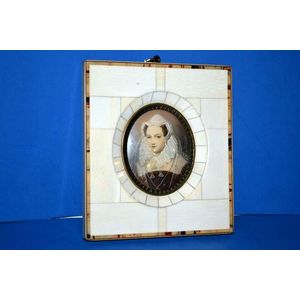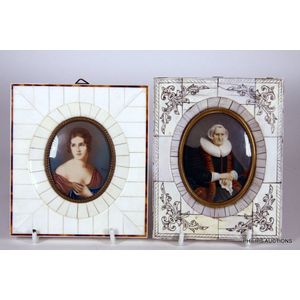Miniature Paintings in Ivory Frames
Two miniature paintings in ivory frames, 20th century, two finely painted oval miniatures, one of an older Dutch woman in 17th century attire with a lace bonnet and Elizabethan collar, and a Regency styled younger woman, both signed and housed in ivory tile frames, one with engraved and inked spandrel decoration. Height 14.5 cm. Width 11.5 cm
You must be a subscriber, and be logged in to view price and dealer details.
Subscribe Now to view actual auction price for this item
When you subscribe, you have the option of setting the currency in which to display prices to $Au, $US, $NZ or Stg.
This item has been sold, and the description, image and price are for reference purposes only.
- Elizabethan - Strictly speaking, furniture usually in oak, made in the reign of Elizabetht I, from 1558 to 1603. The style incororates elaborate and ostentatious carving of classicial figures and themes and bulbous baluster legs, with an Italian Renaissance influence. When a piece is described as "Elizabethan style", it mimics the attributes of the Elizabethan period, but was made at a later date.
- Regency Period - The Regency period in English furniture design refers to the period when King George III, was declared unfit to rule in 1811, and his son ruled as proxy as Prince Regent, until 1820, and then, after the death of his father as George IV until his death in 1830. The Regency period was preceded by the Georgian period (George I, George II, and George III: 1714 - 1811), and was followed by the William IV period, which only lasted until 1837 when William IV died as was succeeded by Queen Victoria.
- Ivory - Ivory is a hard white material that comes from the tusks of elephants, mammoth, walrus and boar, or from the teeth of hippopotamus and whales. The ivory from the African elephant is the most prized source of ivory. Although the mammoth is extinct, tusks are still being unearthed in Russia and offered for sale.
Ivory has been used since the earliest times as a material for sculpture of small items, both in Europe and the east, principally China and Japan.
In Asia ivory has been carved for netsuke, seals, okimono, card cases, fan supports, animals and other figures and even as carved tusks.
In the last 200 years in Europe ivory has been used to carve figures, for elaborate tankards, snuff boxes, cane handles, embroidery and sewing accessories, in jewellery and as inlay on furniture. Its more practical uses include being used for billiard balls, buttons, and a veneers on the top of piano keys.
The use and trade of elephant ivory have become controversial because they have contributed to Due to the decline in elephant populations because of the trade in ivory, the Asian elephant was placed on Appendix One of the Convention on International Trade in Endangered Species (CITES), in 1975, and in January 1990, the African elephant was similarly listed. Under Appendix One, international trade in Asian or African elephant ivory between member countries is forbidden. Unlike trade in elephant tusks, trade in mammoth tusks is legal.
Since the invention of plastics, there have been many attempts to create an artificial ivory
This item has been included into following indexes:
-
miniatures
- 20th century 108
- portrait and other 1,223
- signed by the artist 272
Visually similar items

Two hand painted portrait miniatures, signed Stieler, depicting Wilhelmine Sulzer and Irene Pallavicini, in ivory clad frames, 14 cm x 10.5 cm
Sold by
in
for
You can display prices in $Au, $US, $NZ or Stg.

A pair of Louis XV style piano key ivory miniatures of the court beauties, 20th century
Sold by
in
for
You can display prices in $Au, $US, $NZ or Stg.

Two hand decorated portrait miniatures, both in matching frames & signed, 14 cm x 12 cm (frame).
Sold by
in
for
You can display prices in $Au, $US, $NZ or Stg.

Framed painted portrait miniature in ivory frame
Sold by
in
for
You can display prices in $Au, $US, $NZ or Stg.
